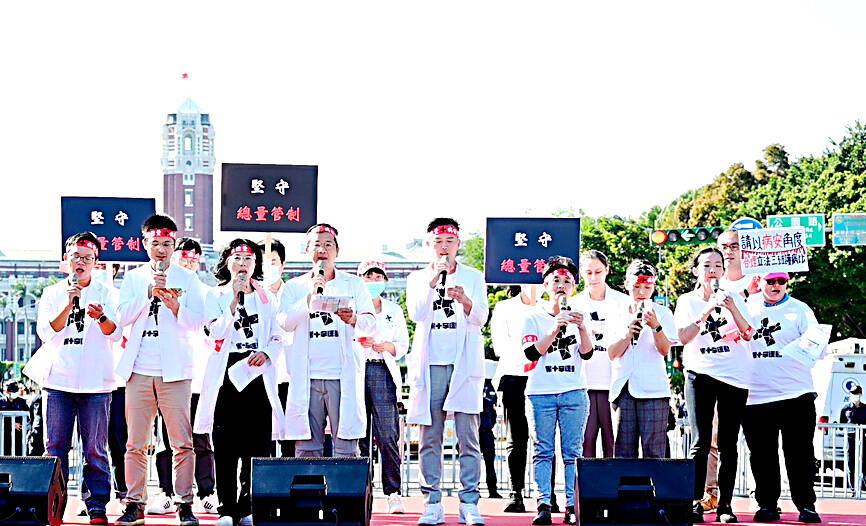Hundreds of Taiwan League of Healthcare Workers members yesterday gathered in front of the Presidential Office Building for the “Black Cross Movement” rally and urged the government to set a principle for determining the healthcare professional quota and to put it into law.
The league, consisting of trade unions of nurses, pharmacists, Chinese medicine practitioners, physicians and dentists, held the rally on Taipei’s Ketagalan Boulevard in the afternoon.
It said that healthcare workers’ work environment continues to worsen, and many people have left their posts disappointed, while the Ministry of Education (MOE) and the Ministry of Health and Welfare (MOHW) ignore the real problem and are considering expanding medical school enrollment quotas.

Photo: Chu Pei-hsiung, Taipei Times
Casually expanding enrollment quotas would lead to poorer personnel quality and worsen the work environment, as there might be many healthcare workers with insufficient experience, it said, adding that the newer recruits might leave the workforce more easily, leading to the destruction of the nation’s healthcare system.
It urged the MOHW to discuss a principle regarding the healthcare professional quota with them and put it into law.
“The red cross represents us health workers, so the ‘black cross’ refers to [the government] discrediting and neglecting our demands,” the group’s co-convener, plastic surgeon Tsai Feng-chou (蔡豐州) said, wearing a red headband with a black cross in the middle and words reading: “Quota restriction, patient safety.”
Tsai said that Taiwan’s healthcare spending as a percentage of its GDP is lower than many developed countries, and the payment points for medical services in the National Health Insurance (NHI) system has dropped to a record low, causing more healthcare workers to leave the workforce.
The government should learn a lesson from previous quota expansions in higher education which led to university shutdowns along with unemployed teachers and lawyers, said rally co-convener Lin Yuan-min (林元敏), a professor at National Yang-Ming University’s dentistry department.
Pharmacist Cheng Wen-po (鄭文柏) said there are about 13 pharmacists per 10,000 people in Taiwan, which is higher than the five per 10,000 people rate suggested by the WHO and the average rate of about 8.6 per 10,000 people of OECD economies.
The MOE previously allowed the Tzu Chi University in Hualien County to establish a new department of pharmacy, saying that the county has an insufficient amount of pharmacists, he said, adding that the data from August shows that the rate of pharmacists in Hualien and Taitung counties were 13 and 17 per 10,000 people respectively, Cheng said.
Another co-convener, Chen Chia-fan (陳嘉帆), a Chinese medicine practitioner, said that since a 2019 projection of the National Health Research Institutes showed there might be a bigger supply of Chinese medicine practitioners than the demand in 2028, there is no need to increase Chinese medicine departments’ enrollment quotas.
The Minister of Education Pan Wen-chung (潘文忠) in 2018 promised that an enrollment restriction would be imposed on Chinese medicine departments to ensure higher education quality, Chen said, adding that the ministry should keep its promise and put such restriction into law.

REPORT: Taipei has expressed an interest in obtaining loitering munitions matching the AeroVironment Switchblade 300 or the Anduril Altius-600, ‘Foreign Policy’ said Taiwan is seeking US-made kamikaze drones in an apparent concession to pressure from Washington to focus on asymmetric capabilities to defeat or deter a Chinese attack, Foreign Policy said in a report on Wednesday. Taipei has expressed an interest in obtaining AeroVironment Switchblade loitering munitions or other devices with similar capabilities, it said, citing four sources familiar with the matter commenting on condition of anonymity. The Switchblade 300 is a tube-launched drone designed for attacking ground troops, while its larger sibling, the Switchblade 600, could be used to destroy tanks and entrenched troops. Ukraine has utilized both systems extensively in its fight against

Police officers yesterday morning apprehended the prime suspect of a triple homicide case, after raiding the suspect’s hideout in Taichung. They transported the suspect to New Taipei City for questioning and recorded his statement last night. The suspect, identified as a 24-year-old man surnamed Chang (張), is believed to have used his hands to strangle his wife, surnamed Chen (陳), 29, along with his three-year-old son from a previous marriage and his wife’s mother, 69. The three dead bodies were wrapped in blankets when they were discovered inside their apartment in New Taipei City’s Sanchong District (三重) on Saturday. Chang was holding a

Hungarian Member of Parliament Tompos Marton said he considers Taiwan to be a better alternative to China as a strategic partner. Marton, who is the vice president of the opposition Momentum Party, made the remarks in an interview with the Central News Agency on Sunday. He draped a Republic of China flag across his shoulders to protest Chinese President Xi Jinping’s (習近平) visit to the capital city, Budapest, on Thursday last week, and openly voiced support for Taiwan on social media. He said in the interview that he wanted to remind the world that there were alternatives to China, and that “Taiwan has

A female physician at New Taipei City’s Shuang Ho Hospital was bullied and made to work for 32 consecutive hours by a senior colleague while pregnant before later having a miscarriage, an internal investigation found, the hospital said on Monday. The perpetrator has been removed from his post, the hospital said. The attending physician in the hospital’s Medical Imaging Department, identified by the pseudonym Y, earlier on Monday told reporters that she had been bullied by a male senior colleague who arranged shifts in her department. In January, shortly after she became pregnant, Y asked the department director if she could avoid overnight